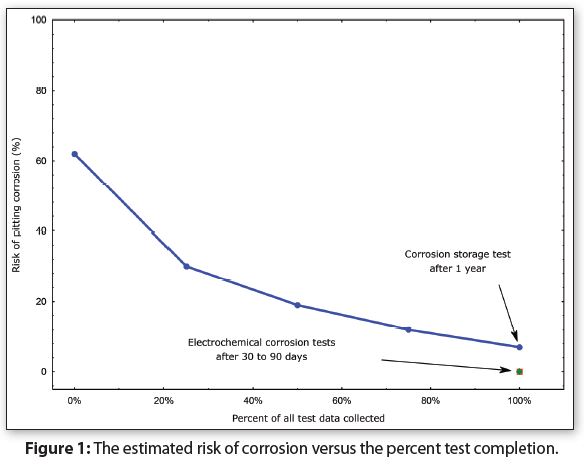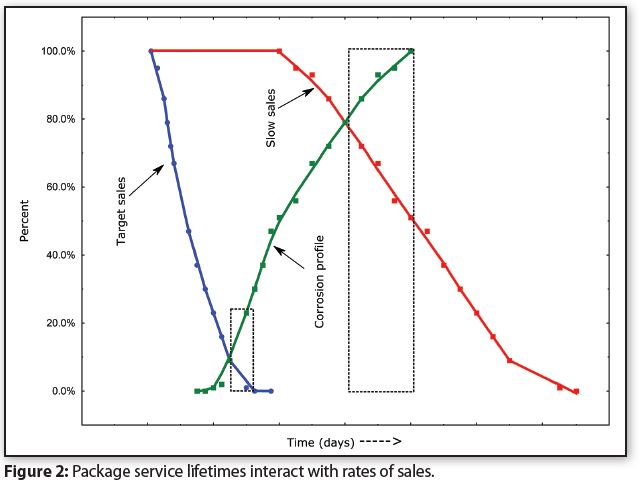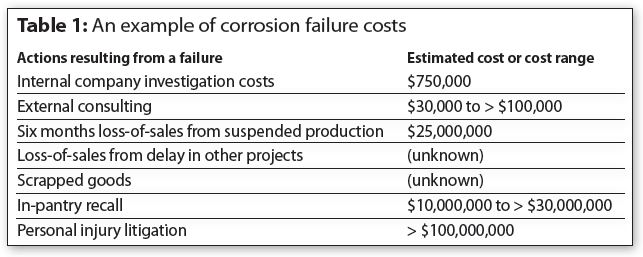Written on: August 1, 2023 by W. Stephen Tait
Hello, everyone. Your spray products have probably both changed and evolved over time. Changes/evolutions are driven by the desire to have:
1. Sustainable raw materials;
2. Environmentally friendly (Green) raw materials;
3. Water used as a solvent instead of petrochemicals;
4. New ingredient technologies; and
5. New package material technologies, to name a few.
All of these changes/evolutions provide the unwanted possibility of transforming a formula that was typically non-corrosive to one that is very corrosive.
Indeed, a change/evolution that transforms a formula into a severely corrosive one often leads to unexpected package leaking. In other words, changes to a product’s formula ingredients and package materials can result in corrosion that was normally not experienced prior to the changes.
Corrosion risk is always present
Package corrosion is always present, as illustrated in Figure 1. The base corrosion risk is approximately 62% when either no-corrosion tests are conducted or relevant corrosion data is not available.
The graph for storage testing in Figure 1 is an empirical corrosion-risk graph that was estimated from spray package corrosion observed in over 7,500 spray packages. The risk magnitude is similar for other types of consumer goods packaging, such as food containers, pumps and tubes.

Notice in Figure 1 that the corrosion risk is significantly reduced to approximately 2%–7% after one year of storage testing (using appropriate test and sampling parameters), and less than 1% after 30–90 days with appropriate electrochemical corrosion test parameters. I refer to these lower risks as information-based corrosion risks, because they are based on corrosion test data. The risk decreases faster with the electrochemical testing because it uses sensitive instruments that can measure corrosion long before it can be seen.
Will consumers observe leaking packages?
Whether or not consumers observe leaking packages is determined by two factors: the package corrosion rate and the rate of sales. Fast corrosion appears more quickly and results in consumer-observed package leaking. Very slow corrosion typically does not cause consumer-observed package leaking when sales are timely (on-target), and when all packages are exhausted and in the recycle stream before they leak.
The rate of sales is essentially the time it takes to sell all units from a given manufacturing batch of product. Figure 2 illustrates how a given failure-time profile (green graph) interacts with both on-target and slow sales. On-target sales (blue graph) produce a very low percentage of leaking packages that are typically not seen by consumers. Slow sales (red graph)—caused by a pandemic or a recession—produce a situation where a significant number of leaking packages are seen by consumers.

Corrosion failure disrupts company operations
Package failure investigations are typically not a regular budget item. Thus, a package failure disrupts production and typically triggers initiation of a non-budgeted internal investigation into the root cause of the failure. An internal investigation typically lasts from 6 to > 12 months, depending on the number of manufacturing batches and units sold.
The investigation team typically includes personnel from all R&D disciplines (including management)—Manufacturing, Quality Assurance, Legal, Marketing, Sales and Customer Service. A failure could also include one or more members of senior management, such as the Chief Science Officer, CEO, CFO, Legal Counsel, etc.
Consequently, an internal failure investigation team could include total of 10–30 personnel (usually not all involved at the same time). An investigation also often includes vendor personnel and external consultants.
Corrosion failure costs
Figure 1 illustrated that the risk associated with no-corrosion-data (testing) is high (~62%). I’ve been involved in multiple failure investigations, and my experience has been that most of them
take approximately one year to complete. Table 1 summarizes an example of corrosion costs for a failure.
The costs in Table 1 are based on the assumptions of:
• 3,000 hours of personnel time in one year
• $250 per hour internal personnel costs
• The failed product has an annual sales of $50,000,000
• $30,000 to > $100,000 for external consultant(s)
• $10,000,000 to > $30,000,000 for product recalls
• $100,000,000 for personal injury litigation (based on estimates from several personal-injury attorneys)
Are corrosion tests cost effective?
The cost summary in Table 1 indicates that the minimum cost for a corrosion failure could be at least $135,780,000 when a product recall and personal injury litigation are involved.
Consequently, the cost of corrosion testing is significantly less than the cost of a corrosion failure. Indeed, the minimum cost for a failure would easily fund corrosion tests for multiple decades.
Corrosion testing also helps prevent leaking packages for new products, products with new ingredient technologies, alternate raw material vendors, packages with new material technologies and changes to both ingredient and package vendors.
Thanks for your interest and I’ll see you in September. Contact me at 608-831-2076; rustdr@pairodocspro.com or from our two websites: pairodocspro.com and aristartec.com. SPRAY
